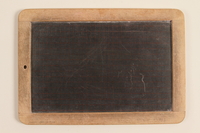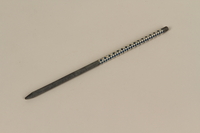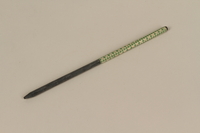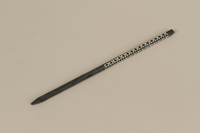Overview
- Brief Narrative
- Leather tornister schoolbag used by a student in Germany during and before the Holocaust. Tornister bags originated in the German military during the 17th century, and were traditionally made out of leather or canvas stretched over a wooden frame. Later, German schoolchildren began using the bags to carry their books and school materials. After Adolf Hitler was appointed chancellor of Germany in 1933, the Nazi authorities passed new laws that dictated who could teach and be educated in the German school system. Quotas restricting the number of Jewish students who could attend public schools were established. Under the Restoration of the Professional Civil Service Act, Jewish teachers or ones considered “politically unreliable” were purged from schools, and Nazi Party membership was compulsory for all remaining teachers. At the entrance to school, students had to lift their arms and say, “Heil Hitler!” School curriculum was changed to emphasize sports, history, and racial science with the purpose of indoctrinating students with Nazi ideology. Subjects such as religion became less important, and were eventually removed from the curriculum altogether. Any textbooks used to educate students had to be approved by the party. Censors removed books that did not meet these standards from the classroom, and introduced new textbooks that taught students militarism, racism, antisemitism, obedience to state authority, and love for Hitler. Instruction aimed to produce race-conscious, obedient Germans who would be willing to die for the Führer and Fatherland. Nordic and other “Aryan” races were glorified, while Jews and other peoples were deemed inferior.
- Date
-
creation:
approximately 1930
- Geography
-
use:
Germany
- Credit Line
- United States Holocaust Memorial Museum Collection, Gift of Schulmuseum Berlin.
- Markings
- interior flap, back, printed, black ink : Betina Muller, Penig, Leipz. Str. 2
- Contributor
-
Original owner:
Betina Muller
Physical Details
- Language
- German
- Classification
-
Containers
- Category
-
Luggage
- Object Type
-
Schoolbags (lcsh)
- Genre/Form
- Bags.
- Physical Description
- Light brown-colored, square-shaped, leather schoolbag with rounded edges, two long, thin leather straps, and a front flap closure. The body of the bag consists of three large pieces of leather stitched together with thick thread. The largest piece forms the front body, and then curves backward at the bottom to form the wide, straight back body before curving forward at the top to form the flap closure. Each side is formed by a rectangular piece of leather with rounded top and bottom ends. The edges of each side panel are folded and sewn to the interior edges of the main body of the bag, and secured with a rivet in both upper corners. The flap is secured by a centered, thin leather strap that slides into a metal, single-tongue buckle sewn on the center of the front body. The ends of two long shoulder straps are sewn on either side of the buckle. They extend across the top of the bag, before being threaded through a metal loop sewn in the center of the back body. The straps cross, extend down, and attach to the rounded bottom corners of the bag. The left strap is attached with a metal, single-tongue buckle, and the right strap is attached with a small rounded hook. Both are sewn to the bag via small, leather tabs. The interior of the bag is soft leather and has a line of black, German text stamped inside. The front and back are decorated with square-shapes, one inside the other, pressed into the surface. The exterior of the back has small stains, and light scratches throughout.
- Dimensions
- overall: Height: 10.250 inches (26.035 cm) | Width: 13.375 inches (33.973 cm) | Depth: 4.250 inches (10.795 cm)
- Materials
- overall : leather, metal, thread, ink
Rights & Restrictions
- Conditions on Access
- No restrictions on access
- Conditions on Use
- No restrictions on use
Keywords & Subjects
Administrative Notes
- Legal Status
- Permanent Collection
- Provenance
- The schoolbag was donated to the United States Holocaust Memorial Museum in 1990 by the Schulmuseum Berlin.
- Record last modified:
- 2022-07-28 22:05:38
- This page:
- https://collections.ushmm.org/search/catalog/irn521575
Download & Licensing
In-Person Research
- By Appointment
- Request 21 Days in Advance of Visit
- Plan a Research Visit
- Request to See This Object
Contact Us
Also in Schulmuseum Berlin collection
The collection consists of a leather schoolbag, a blackboard, three slate pencils, a wood pencil case, and school–related documents used in Germany before and during the Holocaust.
Date: 1925-1945

Small slate and wood blackboard used by a student in Nazi Germany
Object
Wood-framed slate blackboard used by a student in Germany before and during the Holocaust. Slate blackboards were made from thin sheets of slate stone and were used to complete schoolwork before the widespread use of paper. Students originally wrote with slate pencils, made from softer stone, but later switched to soft chalk. After Adolf Hitler was appointed chancellor of Germany in 1933, the Nazi authorities passed new laws that dictated who could teach and be educated in the German school system. Quotas restricting the number of Jewish students who could attend public schools were established. Under the Restoration of the Professional Civil Service Act, Jewish teachers or ones considered “politically unreliable” were purged from schools, and Nazi Party membership was compulsory for all remaining teachers. At the entrance to school, students had to lift their arms and say, “Heil Hitler!” School curriculum was changed to emphasize sports, history, and racial science with the purpose of indoctrinating students with Nazi ideology. Subjects such as religion became less important, and were eventually removed from the curriculum altogether. Any textbooks used to educate students had to be approved by the party. Censors removed books that did not meet these standards from the classroom, and introduced new textbooks that taught students militarism, racism, antisemitism, obedience to state authority, and love for Hitler. Instruction aimed to produce race-conscious, obedient Germans who would be willing to die for the Führer and Fatherland. Nordic and other “Aryan” races were glorified, while Jews and other peoples were deemed inferior.

Slate pencil covered with a blue patterned wrapper used by a student in Nazi Germany
Object
Slate pencil used by a student in Germany before and during the Holocaust. Slate pencils were used by students to write on slate blackboards, or slates, which were made from thin sheets of stone. The slate pencils were made from a softer stone. After Adolf Hitler was appointed chancellor of Germany in 1933, the Nazi authorities passed new laws that dictated who could teach and be educated in the German school system. Quotas restricting the number of Jewish students who could attend public schools were established. Under the Restoration of the Professional Civil Service Act, Jewish teachers or ones considered “politically unreliable” were purged from schools, and Nazi Party membership was compulsory for all remaining teachers. At the entrance to school, students had to lift their arms and say, “Heil Hitler!” School curriculum was changed to emphasize sports, history, and racial science with the purpose of indoctrinating students with Nazi ideology. Subjects such as religion became less important, and were eventually removed from the curriculum altogether. Any textbooks used to educate students had to be approved by the party. Censors removed books that did not meet these standards from the classroom, and introduced new textbooks that taught students militarism, racism, antisemitism, obedience to state authority, and love for Hitler. Instruction aimed to produce race-conscious, obedient Germans who would be willing to die for the Führer and Fatherland. Nordic and other “Aryan” races were glorified, while Jews and other peoples were deemed inferior.

Slate pencil covered with a green patterned wrapper used by a student in Nazi Germany
Object
Slate pencil used by a student in Germany before and during the Holocaust. Slate pencils were used by students to write on slate blackboards, or slates, which were made from thin sheets of stone. The slate pencils were made from a softer stone. After Adolf Hitler was appointed chancellor of Germany in 1933, the Nazi authorities passed new laws that dictated who could teach and be educated in the German school system. Quotas restricting the number of Jewish students who could attend public schools were established. Under the Restoration of the Professional Civil Service Act, Jewish teachers or ones considered “politically unreliable” were purged from schools, and Nazi Party membership was compulsory for all remaining teachers. At the entrance to school, students had to lift their arms and say, “Heil Hitler!” School curriculum was changed to emphasize sports, history, and racial science with the purpose of indoctrinating students with Nazi ideology. Subjects such as religion became less important, and were eventually removed from the curriculum altogether. Any textbooks used to educate students had to be approved by the party. Censors removed books that did not meet these standards from the classroom, and introduced new textbooks that taught students militarism, racism, antisemitism, obedience to state authority, and love for Hitler. Instruction aimed to produce race-conscious, obedient Germans who would be willing to die for the Führer and Fatherland. Nordic and other “Aryan” races were glorified, while Jews and other peoples were deemed inferior.

Slate pencil covered with blue patterned paper used by a student in Nazi Germany
Object
Slate pencil used by a student in Germany before and during the Holocaust. Slate pencils were used by students to write on slate blackboards, or slates, which were made from thin sheets of stone. The slate pencils were made from a softer stone. After Adolf Hitler was appointed chancellor of Germany in 1933, the Nazi authorities passed new laws that dictated who could teach and be educated in the German school system. Quotas restricting the number of Jewish students who could attend public schools were established. Under the Restoration of the Professional Civil Service Act, Jewish teachers or ones considered “politically unreliable” were purged from schools, and Nazi Party membership was compulsory for all remaining teachers. At the entrance to school, students had to lift their arms and say, “Heil Hitler!” School curriculum was changed to emphasize sports, history, and racial science with the purpose of indoctrinating students with Nazi ideology. Subjects such as religion became less important, and were eventually removed from the curriculum altogether. Any textbooks used to educate students had to be approved by the party. Censors removed books that did not meet these standards from the classroom, and introduced new textbooks that taught students militarism, racism, antisemitism, obedience to state authority, and love for Hitler. Instruction aimed to produce race-conscious, obedient Germans who would be willing to die for the Führer and Fatherland. Nordic and other “Aryan” races were glorified, while Jews and other peoples were deemed inferior.
Schulmuseum Berlin papers
Document
The collection consists of school-related items including a schoolbag, a blackboard, three pencils, and documents from Germany.
Sliding lid pencil box with a painted scene used by a student in Nazi Germany
Object
Wooden pencil holder used by a student in Germany during the Holocaust. After Adolf Hitler was appointed chancellor of Germany in 1933, the Nazi authorities passed new laws that dictated who could teach and be educated in the German school system. Quotas restricting the number of Jewish students who could attend public schools were established. Under the Restoration of the Professional Civil Service Act, Jewish teachers or ones considered “politically unreliable” were purged from schools, and Nazi Party membership was compulsory for all remaining teachers. At the entrance to school, students had to lift their arms and say, “Heil Hitler!” School curriculum was changed to emphasize sports, history, and racial science with the purpose of indoctrinating students with Nazi ideology. Subjects such as religion became less important, and were eventually removed from the curriculum altogether. Any textbooks used to educate students had to be approved by the party. Censors removed books that did not meet these standards from the classroom, and introduced new textbooks that taught students militarism, racism, antisemitism, obedience to state authority, and love for Hitler. Instruction aimed to produce race-conscious, obedient Germans who would be willing to die for the Führer and Fatherland. Nordic and other “Aryan” races were glorified, while Jews and other peoples were deemed inferior.



